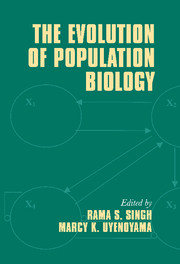Book contents
- Frontmatter
- Contents
- List of contributors
- Publications of R. C. Lewontin
- Preface
- Introduction
- Part I Historical foundations and perspectives
- Part II Genotypes to phenotypes: new genetic and bioinformatic advances
- Part III Phenotypes to fitness: genetics and ecology of populations
- Part IV Genes, organisms, and environment: evolutionary case studies
- 14 Adaptation, constraint, and neutrality: mechanistic case studies with butterflies and their general implications
- 15 Evolution in hybrid zones
- 16 Nine relatives from one African ancestor: population biology and evolution of the Drosophila melanogaster subgroup species
- Part V Applied population biology: biodiversity and food, disease, and health
- Index
16 - Nine relatives from one African ancestor: population biology and evolution of the Drosophila melanogaster subgroup species
Published online by Cambridge University Press: 08 January 2010
- Frontmatter
- Contents
- List of contributors
- Publications of R. C. Lewontin
- Preface
- Introduction
- Part I Historical foundations and perspectives
- Part II Genotypes to phenotypes: new genetic and bioinformatic advances
- Part III Phenotypes to fitness: genetics and ecology of populations
- Part IV Genes, organisms, and environment: evolutionary case studies
- 14 Adaptation, constraint, and neutrality: mechanistic case studies with butterflies and their general implications
- 15 Evolution in hybrid zones
- 16 Nine relatives from one African ancestor: population biology and evolution of the Drosophila melanogaster subgroup species
- Part V Applied population biology: biodiversity and food, disease, and health
- Index
Summary
Introduction
Evolutionary studies have long come across the snag of that elusive evolutionary event called “speciation.” Understanding speciation is understanding species boundaries, and hence the source of biodiversity. Therefore the genetics of speciation has been a major focus of evolutionary biology thinking over the last decade (Coyne 1992, Coyne and Orr 1998, Singh 2000, Wu 2001). However, major questions about speciation have remained unresolved, for instance whether splitting is instantaneous or whether species emerge gradually. Generally there have been two ways of approaching the speciation process: the mapping of speciation phenotypes and “divergence population genetics” as labeled by Kliman et al. (2000).
The gene mapping studies address the genetic architecture of phenotypes that are thought to be instrumental in driving speciation. However, these maps do not indicate which selective factors have actually caused speciation. Among these phenotypes are species-specific adaptations such as the resistance to a host-plant toxin, or “speciation” traits including species-specific mate detection pheromones affecting mating (Coyne 1996, Coyne and Charlesworth 1997), courtship songs affecting sexual isolation, or sperm diversity affecting sperm competition. As genes involved in male fertility are potential targets for sexual selection, it could be that those genes with a sex-related function play a role in reproductive isolation between species, and evolve more rapidly than genes with developmental or metabolic function (Civetta and Singh 1998, Swanson and Vacquier 2002, Kulathinal et al. 2003).
- Type
- Chapter
- Information
- The Evolution of Population Biology , pp. 315 - 344Publisher: Cambridge University PressPrint publication year: 2004
- 19
- Cited by



